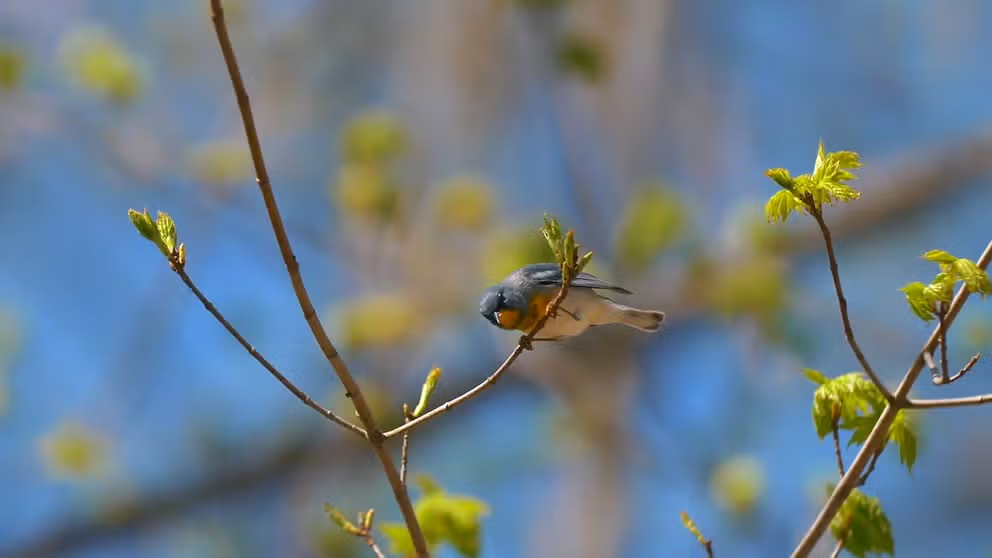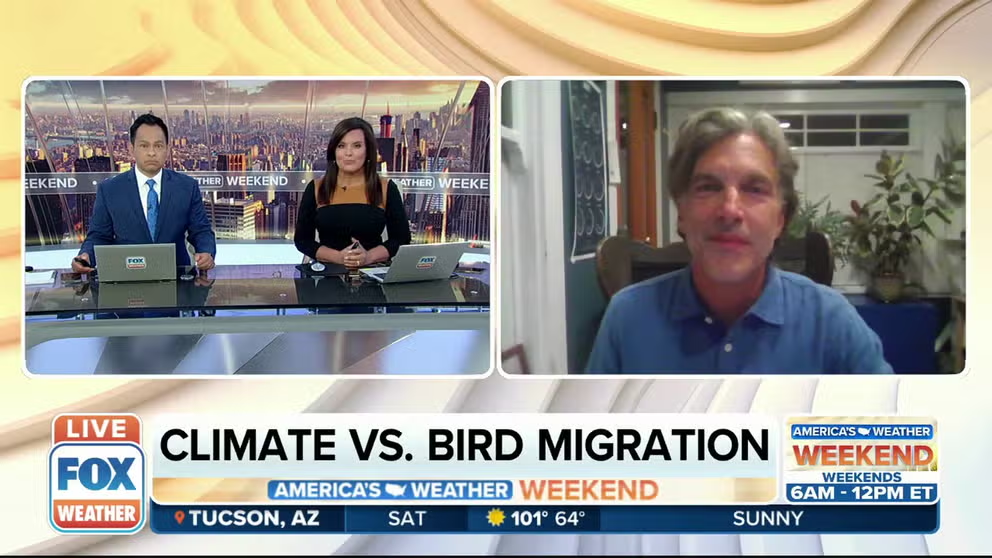For the birds: Project tracks bird migration using NWS Doppler Radar
It's led to valuable insight into how birds migrate, and through meticulous research, ornithologists can now highlight not only where birds are right now, but predict where they're headed next and use that information to help protect their journey.
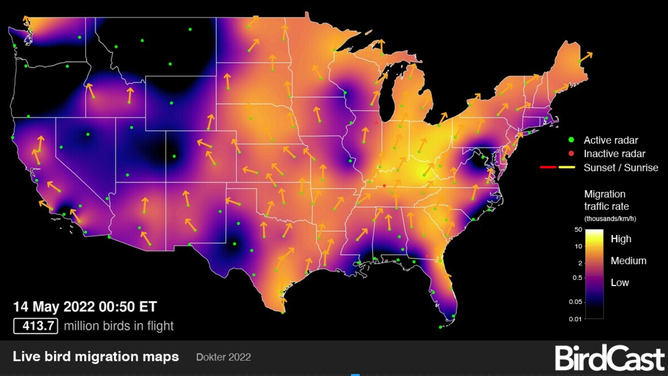
-SPEED+ Real-time analysis maps show intensities of actual nocturnal bird migration as detected by the US weather surveillance radar network between local sunset to sunrise.
(Birdcast)
ITHACA, N.Y. -- You've seen maps all the time that show forecasted weather patterns, but now there is an elaborate project that uses maps to predict and show bird migrations in real-time.
Using the advanced tracking capabilities of National Weather Service Doppler radars, researchers have been able to detect not only where storms are lurking in the atmosphere, but track various biological signals such as insects, bats -- and even birds!
It's led to valuable insight into how birds migrate, and through meticulous research, ornithologists can now highlight not only where birds are right now, but predict where they're headed next and use that information to help protect their journey.
The BirdCast project began 25 years ago as a collaborative effort between Clemson University, Cornell Lab of Ornithology, National Audubon Society, Academy of Natural Sciences, and GeoMarine.
"The concept to capture some element of the spectacle of migration on radar, and share predictions and observations with the public, to inspire a change in people's behaviors… to reduce the application of pesticides during periods of heavy bird migration, that was born then," says Andrew Farnsworth, Senior Research Associate with the Cornell Lab of Ornithology.
LEARN: HOW BIRDS NAVIGATE THE CLOUDS
The project got a big boost in 2013 with the upgrade of NWS radars to use "dual polarization" which uses radar pulses at two angles instead of one, allowing ornithologists to more easily separate birds and other flying creatures from rainfall.
In 2018, a new model was developed that used the NWS Doppler radar data of bird migration intensity and tied it weather data like temperature, wind speed and direction.
"This model learns the associations from 23 years of radar and weather data to determine which weather variables best predict the intensity of migration, producing a forecast of that intensity during the peak period of nightly movement, usually 2-3 hours after local sunset, anywhere in the contiguous U.S.," Farnsworth said. "There is A LOT behind this model, including the history of the evolution of machine learning to automatically extract biology from meteorology in radar data."
The model is updated every 6 hours and predicts bird migrations out to three days in advance for the 2-3 hours after local sunset, and give an aggregate count of expected birds in motion. Over the weekend, the forecast was around 400 million birds in flight!
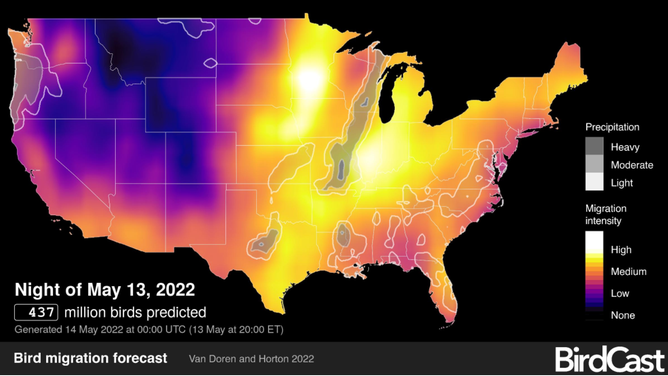
Bird migration forecast maps show predicted nocturnal migration 3 hours after local sunset and are updated every 6 hours. Colorado State University and the Cornell Lab of Ornithology currently produce these forecasts.
(Birdcast)
The site also shows a real-time migration map, using current Doppler Radar data:

-SPEED+ Real-time analysis maps show intensities of actual nocturnal bird migration as detected by the US weather surveillance radar network between local sunset to sunrise.
(Birdcast)
And new as of this spring, the Birdcast site offers a real-time snapshot of the current migration under way in your county or state, showing not only the number of estimated birds that have passed through that area but what kind of birds are making the trek.
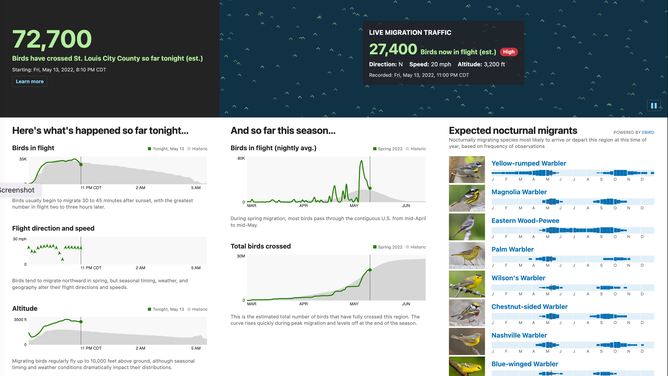
(Birdcast)
How do they know what's a bird versus a bug?
Using algorithms over years of research, scientists can detect the difference between bats, birds and insects. Insects are small enough that they drift or travel in the wind, so their flight paths will align with the prevailing winds. Whereas birds are strong enough to fly across or even into headwinds, so radar targets moving independently of the wind are likely birds.
Bats can do that too, but bats follow a different schedule than most birds. Researchers say birds usually take flight in the 30-45 minutes after sunset during the spring and fall while bats are more active in the summer.
"Being able to track the movement of birds relative to a radar and characterize birds' speeds and directions, etc. offered a MAJOR advance from the previous non-Doppler (radar)," Farnsworth said.
Why do birds migrate in the first place?
Unlike human "snowbirds" who flock to the south in winter to find warmer climates and avoid shoveling snow, for birds, it's more about how to best keep their species going.
"Birds migrate because it's a highly advantageous way to produce more offspring by tracking seasonal pulses of food resources and to occupy these best places to produce more offspring," Farnsworth said. "So, in the evolutionary history of birds, and their movements, seasonality, predictable seasonality, and changes in climate resulting from such predictability, facilitated the evolution of migration system."
LEARN: WHY DO BIRDS SING IN THE SPRING AND SUMMER?
Bird Songs of Spring
Day length, sunlight and instinct give the birds their seasonal cue.
Why just after sunset? According to the National Audubon Society, 80% of birds migrate at night using the night sky to navigate. During the day they rest and refuel before taking off the next night. Nighttime travel also makes it more difficult for predators to spot them.
And the weather has a big impact on when they fly, and the route they take.
"Increasing or decreasing temperature broadly predicts migration, largely because of all the atmospheric changes associated with it," Farnsworth said. "In Northern Hemisphere spring, generally speaking, southerly flow facilitates birds moving from south to north, and increasing temperatures are associated with southerly winds."
In Northern Hemisphere autumn, general westerly, zonal flow facilitates birds moving from north to south, with decreasing temperatures associated with northwesterly and northerly winds. "Generally, temperature, wind direction, pressure, presence of rain all impact birds' decisions to take flight, or not," Farnsworth said. "And of course, stopover habitat where birds are on the ground plays a large role in these distributions and occurrences of birds aloft."
The BirdCast model takes these factors into account when crafting its forecast.
Farnsworth and his team also hope Birdcast will bring awareness to the large nationwide migration patterns.
"You can experience these and understand these movements, which are part of the pulse of our planet, and in grasping even a glimmer of the spectacle, consider how to adapt your behaviors to keep this pulse strong," he said.
How to make your community more bird-friendly
Saturday is World Migratory Bird Day, and people across the globe will be celebrating with migratory bird walks and events at local parks and nature reserves. Light pollution and its impact on migratory birds is this year's theme which strives to raise attention and awareness. John Rowden, senior director of Bird-Friendly Communities for the National Audubon Society, joins FOX Weather.
He offers four tips you can do to help birds survive their long journey:
- Use bird-friendly glass to help birds avoid collisions with your windows. "Reflective glass is a big problem for birds, whether you are a residential or commercial homeowner," Farnsworth said. "Up to a billion birds die annually in the US from collisions. Here's how to make your glass more bird friendly.
- Turn off your lights at night if you don't need them. "Light pollution attracts and disorients birds, and in conjunction with reflective glass contributes significantly to the problem," he said. They've even joined forces with the state of Texas for their Lights Out program, though many other similar projects are under way in other regions.
- Keep your cats inside. "Cats kill more birds than collisions!" Farnsworth says.
- Plant native vegetation.
"There are few opportunities like this to link the coolest technology with the most amazing unseen spectacle to inspire and educate… and ultimately learn how animals move over and connect our planet and how we can protect that," Farnsworth said. "Birds are amazing indicators of the health of our environment - the canary in the coal mine so to speak - and recognizing that there are relatively simple things that we can do to protect birds and their contributions to the planet, that's an essential connection we need to maintain between us and our world!"
